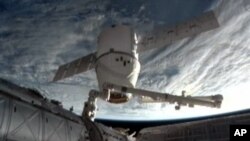CAPE CANAVERAL, FLORIDA —
Privately owned Space Exploration Technologies canceled its planned cargo run to the International Space Station on Monday after a helium leak was found in its rocket's first stage, NASA said.
The launch of the Falcon 9 rocket and Dragon capsule had been slated for 4:58 p.m. EDT (2058 GMT). But an hour before liftoff, engineers reported that the rocket's first stage was leaking helium, prompting a postponement.
The next opportunity for the Falcon 9 to fly is 3:25 p.m. (1925 GMT) on Friday if the problem can be resolved, NASA said in a statement.
The flight, the third of 12 under the firm's 1.6 billion contract with NASA, already had been delayed several times for technical issues, including a potential contamination concern with the rocket and damage to an Air Force ground tracking radar needed to monitor the Falcon's flight.
Another postponement loomed over the weekend after one of two computers that control key space stations systems, including the solar wing panels and a moveable base for the robot arm, failed. A spacewalk is needed to replace the unit, which is located in the station's external framework.
NASA managers decided on Sunday to let SpaceX proceed with launch and scheduled the repair spacewalk for later in the month.
In addition to delivering cargo to the space station, SpaceX plans to use the Falcon's launch to test technology it has been developing to recover and reuse its rockets.
The Falcon 9's first stage holds extra fuel and four landing legs. After it separates from the upper stage and Dragon capsule, the rocket is expected to reignite its engines to slow its descent and position itself for a vertical touchdown on the ocean before toppling over on its side.
“This is a really difficult maneuver,” SpaceX Vice President Hans Koenigsmann told reporters during a news conference on Sunday.
Overall, the company considers the test has less than a 40 percent chance of success.
Eventually, SpaceX hopes to fly its Falcon rockets back to land for refurbishment and reuse.
SpaceX is one of two firms hired by NASA to fly cargo to the station after the space shuttles were retired in 2011. So far, SpaceX has made one test flight and two cargo runs to the station, a project of 15 nations.
Orbital Sciences Corp, which holds a separate $1.9 billion NASA contract, has made one test flight and is preparing for its second resupply mission in June.
The launch of the Falcon 9 rocket and Dragon capsule had been slated for 4:58 p.m. EDT (2058 GMT). But an hour before liftoff, engineers reported that the rocket's first stage was leaking helium, prompting a postponement.
The next opportunity for the Falcon 9 to fly is 3:25 p.m. (1925 GMT) on Friday if the problem can be resolved, NASA said in a statement.
The flight, the third of 12 under the firm's 1.6 billion contract with NASA, already had been delayed several times for technical issues, including a potential contamination concern with the rocket and damage to an Air Force ground tracking radar needed to monitor the Falcon's flight.
Another postponement loomed over the weekend after one of two computers that control key space stations systems, including the solar wing panels and a moveable base for the robot arm, failed. A spacewalk is needed to replace the unit, which is located in the station's external framework.
NASA managers decided on Sunday to let SpaceX proceed with launch and scheduled the repair spacewalk for later in the month.
In addition to delivering cargo to the space station, SpaceX plans to use the Falcon's launch to test technology it has been developing to recover and reuse its rockets.
The Falcon 9's first stage holds extra fuel and four landing legs. After it separates from the upper stage and Dragon capsule, the rocket is expected to reignite its engines to slow its descent and position itself for a vertical touchdown on the ocean before toppling over on its side.
“This is a really difficult maneuver,” SpaceX Vice President Hans Koenigsmann told reporters during a news conference on Sunday.
Overall, the company considers the test has less than a 40 percent chance of success.
Eventually, SpaceX hopes to fly its Falcon rockets back to land for refurbishment and reuse.
SpaceX is one of two firms hired by NASA to fly cargo to the station after the space shuttles were retired in 2011. So far, SpaceX has made one test flight and two cargo runs to the station, a project of 15 nations.
Orbital Sciences Corp, which holds a separate $1.9 billion NASA contract, has made one test flight and is preparing for its second resupply mission in June.









